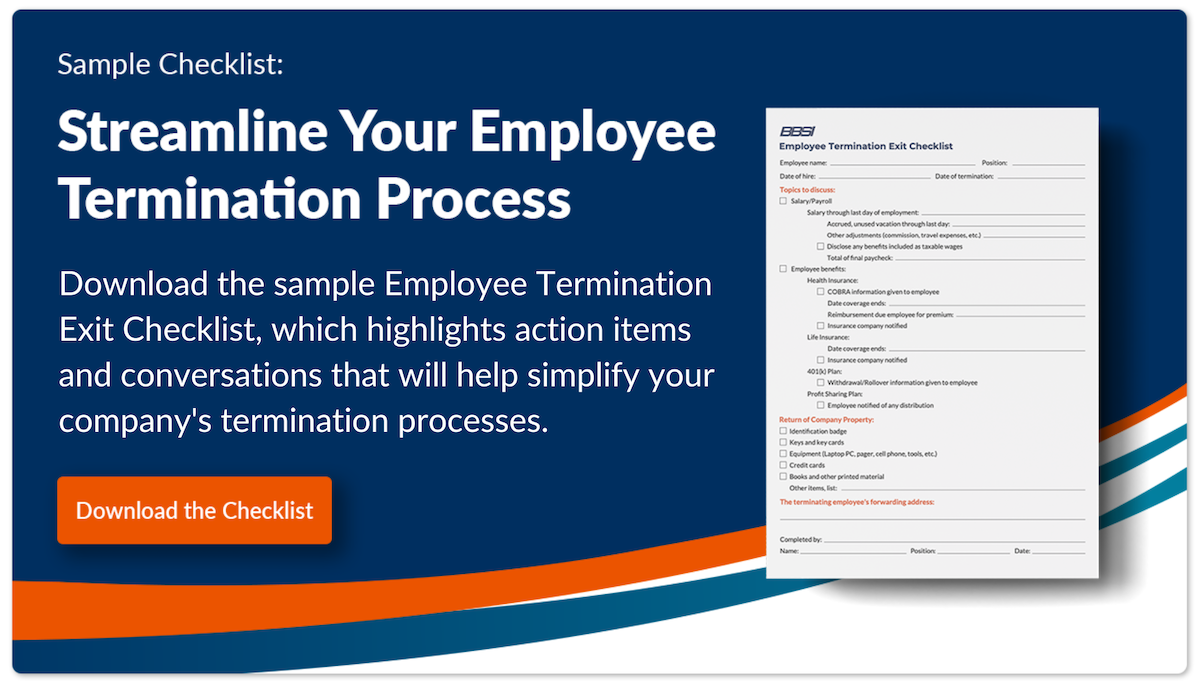
How to Terminate an Employee the Correct Way
Terminating an employee is never an easy decision to make, even when it’s necessary. It's important to ensure the termination process is handled correctly in order to avoid legal issues and protect the business.
This article will provide guidance on how to terminate an employee the right way, including tips on how to communicate with them, which legal considerations must be taken into account, and how to handle their transition out of the company.
Reasons a Company May Terminate an Employee
Organizations may consider terminating an employee for the following reasons:
- They are a bad fit for the role, lacking the necessary skills or experience.
- They don’t fit into your team or company culture. For example, the individual may struggle to mesh with the workflow of an otherwise harmonized team.
- The individual experiences performance-related issues, such as missed deadlines, late arrivals to the workplace, or low-quality work.
- Your organization is experiencing significant changes, such as workforce reductions, reorganizations, or departmental shutdowns.
Regardless of the reason, the correct process for terminating an employee depends on the type of employment agreement in place:
- At-will: Employers and employees retain the right to end employment at any time and for any reason, excluding discrimination or any other illegal reason.
- Contract: Employers must demonstrate “just cause” for the termination. Contract stipulations regarding just causes likely include instances of illegal activity, but contracts may include additional inviolable requirements for employees to adhere to.
Preventing Terminations With Corrective Action
Before an organization decides to terminate an employee, it should consider implementing a corrective action plan. This enables two possible outcomes; (1) the employee corrects the identified issues, or (2) the employer has the documentation to demonstrate the validity of the termination.
The following steps serve as a guide for developing corrective action plans:
- Start the process as early as possible: Organizations need to provide clearly-defined job descriptions and a code of conduct for employees to officially acknowledge, typically by signing an employee handbook at the start of their employment. A clear job description will also help employees understand their responsibilities.
- Conduct regular performance reviews: Check-ins and reviews help employees understand their performance and provide a sense of job security. Organizations should follow a formalized process for reviews by documenting feedback, acknowledging areas for improvement, creating an action plan, and confirming plan accomplishments.
- Implement leadership or management training: Most managers require training for their role, and especially for corrective action plans. Micromanagement or an inability to communicate goals, provide constructive feedback, or handle questions and concerns leaves employees frustrated and unsure of how to respond to corrective action or accomplish their usual responsibilities.
- Implement a process based on content, patterns, and relationships (CPR): Conversations with employees regarding corrective action should involve the “content” of a workplace issue, emerging “patterns,” and their effect on “relationships.” This technique opens up dialogue, reinforces accountability, and creates opportunities for resolution.
- Document corrective action plan progress: If an organization finds the corrective action plan isn’t working for a given employee and termination may be needed, the organization must have the documentation available to defend itself if the employee takes any legal action.
What Are the Risks of Improperly Firing an Employee?
Improper termination always risks severing a relationship and damaging your company's reputation. For example, improper termination may lead to poor online reviews on sites like Glassdoor, affecting your recruitment. However, the most damaging outcome is if the employee pursues legal action against your business. Organizations can mitigate their risk by following the steps listed above.
Clearly documented and signed policies and expectations, training, and records of corrective action plans will provide you with a robust, evidence-based defense.

Employee Termination Best Practices
Unfortunately, terminating employees is part of running a business and managing your workforce. When that happens, you’ll want to keep these best practices in mind.
Stay Calm and Objective
In most cases, employees at risk of termination due to poor performance recognize their circumstances, and they’re less likely to blame the employer if the organization handles the process well.
Employers should never facilitate or participate in an argument while holding a termination meeting. Employees may use an argument’s contents as motivation for legal action or as evidence. If an employee initiates an argument, stay calm and simply reiterate that the decision is final.
To help you remain calm and objective, always include a witness. The witness' responsibilities should exclusively focus on documenting the meeting for legal purposes rather than participation in the conversation. However, if de-escalation is necessary, they can also provide another perspective and help calm the employee.
Meet Face-to-Face
Meeting face-to-face helps ensure the employee’s acknowledgment of their termination and accurate communication. It also demonstrates professional courtesy and imparts compassion — influenced by body language and inflection — for the employee’s situation. Written terminations carry significantly more opportunity for misinterpretation or perceived malice.
If you can’t meet with the employee face-to-face, schedule a video call to avoid miscommunication.
Less Is More
Managers who say too much during a termination may say something that exposes the organization to legal issues. Keep the discussion to the essentials, reiterate the decision is final (if warranted), and prepare a written statement that summarizes the verbal termination notice, the cause, the date, and the return of personal effects or company property.
Use the written statement to guide the meeting, remain focused, and prevent emotions from escalating. After the meeting concludes, file the statement in the employee’s personnel record to officially document the given notice.
Both organizations and employees find surprise terminations the most challenging to navigate due to the potential for intense emotions, perceived unfairness, and legal action. If a sudden termination follows employees violating a zero-tolerance policy, you should stress the policy, document any comments, and inform them of their termination as soon as possible.
Have Documentation
Maintaining thorough documentation allows an organization to easily demonstrate just cause for termination during the termination meeting and if legal action follows. With documentation, you can point to the employee’s performance challenges or violations and your company’s attempts to help correct the issue.
Corrective action plans should serve as a reference when preparing the written statement and during the meeting regarding the termination’s cause. They provide the official record of behavior and help summarize which corrective efforts took place. If needed, refer to past meetings with dates and relevant feedback.
How To Terminate an Employee
A comprehensive termination process includes the following steps.
1. Observe and Communicate Issues With the Employee
Establish expectations and communicate any issues or concerns as early as possible. This helps provide legal protection, opportunities to resolve the problem via corrective action, and prevents questions like, “This wasn’t the first time, so why am I being informed now?”
2. Document a Corrective Action and Performance Improvement Plan (PIP)
Without documentation, organizations can’t prove a corrective action plan took place if the terminated employee pursues legal action.
If corrective action primarily focuses on improving performance rather than behavior or other policy violations, it should involve a formalized and documented PIP to help protect the employer and provide the employee with a roadmap.
3. Make the Decision and Prepare to Terminate the Employee
Before terminating an employee, discuss the decision with the appropriate department heads and team leads as needed to solicit their input. Multiple accounts of workplace violations or issues will help provide evidence of reasonable termination and “just cause.”
Before calling the employee in for the termination meeting, prepare yourself and all the items you’ll need for the meeting, including:
- Corrective action documentation
- Written statement of termination
- The employee’s final check
- A witness
- Any termination papers requiring their signature
Make sure to give yourself and your teams enough time to prepare these documents, which may take payroll or other departments a few hours to process.
4. Schedule the Termination Meeting
Termination meetings should happen discreetly. Aim for a time of day that offers employees more privacy, like the start of their day.
5. Give Them Their Final Pay and Other Necessary Forms
Provide the employee with all necessary termination documents — like a Change of Relationship form and unemployment resources like California’s DE2320 — along with their final check.
Here are a few special considerations for final checks to keep in mind:
- Terminated employees must receive payouts for accrued vacation time. If this requires an additional check, inform them.
- Their check may need to include compensation for the time worked on the day of the termination.
- Consider state laws regarding processes and timing. For example, California businesses must provide the final check on the same day of termination or within 72 hours if the employee quits.
- The California Department of Industrial Relations states direct deposit authorizations immediately become void following an employee’s termination or notice of resignation. However, direct deposit remains an option if the terminated employee requests it.
6. Remove Access to Company Accounts and Ask Them to Return Company Property
Remove or disable the employee’s access to digital tools and company portals immediately following termination. Employers generally remember to enforce physical security, such as reclaiming badges and changing building codes, but they often forget to revoke digital access. Revoke access or change the passwords to all user accounts assigned to the terminated employee, especially if they involve cloud access.
In addition to digital access, terminated employees must return any company property in their possession. While employers can’t withhold a final check until an employee returns the property, they may be able to deduct replacement costs depending on state laws.
7. Communicate the Termination to the Parties Involved
Following an employee termination, be proactive in informing their team members and other relevant parties — like collaborating departments or third-party contacts for accounts they managed — but keep the information to the minimum. Be prepared to hold meetings for any employees who may have related concerns over the termination, such as potential organizational changes or whether more terminations may follow.
Getting in front of the news allows you to prevent rumors and inaccuracies from spreading and helps reassure your employees after a surprising termination.
How BBSI Helps Companies With Employee Misconduct and Terminations
Navigating a termination presents any organization with a challenge that requires HR expertise, and BBSI’s professionals are always ready to help.
When organizations partner with BBSI, they receive coaching on corrective action plans and how to conduct feedback or disciplinary meetings before a termination. When a termination occurs, BBSI will assist with the forms, final check, and other processes. Throughout the termination process, our HR Consultants will provide you with the resources you need to keep you progressing toward your goals.
Contact us today to learn more about how BBSI can help you navigate termination difficulties and implement frameworks for a stable workforce.
Disclaimer: The contents of this white-paper/blog have been prepared for educational and information purposes only. Reference to any specific product, service, or company does not constitute or imply its endorsement, recommendation, or favoring by BBSI. This white-paper/blog may include links to external websites which are owned and operated by third parties with no affiliation to BBSI. BBSI does not endorse the content or operators of any linked websites, and does not guarantee the accuracy of information on external websites, nor is it responsible for reliance on such information. The content of this white-paper/blog does not provide legal advice or legal opinions on any specific matters. Transmission of this information is not intended to create, and receipt does not constitute, a lawyer-client relationship between BBSI, the author(s), or the publishers and you. You should not act or refrain from acting on any legal matter based on the content without seeking professional counsel.

